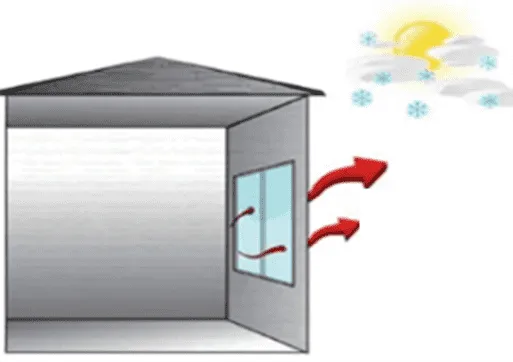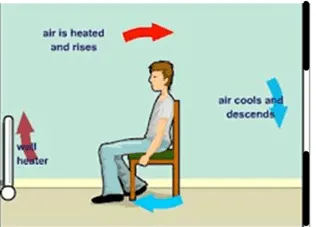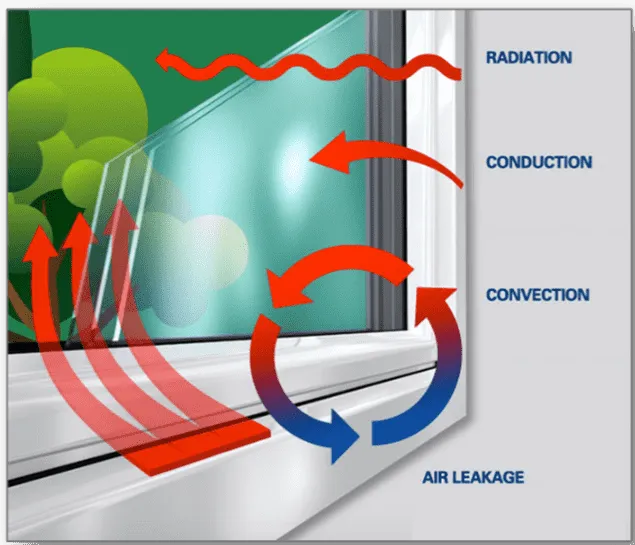The great escape: How to stop heat loss in your home.
If you want to have a cosy home, you need to insulate. Double glazing is the best way to provide insulation through your windows. Increase the performance of that double glazing further by including high-performing Low-E.
Heat and cold will always try to reach equilibrium (heat cools down when in contact with cold, and cold warms up when in contact with heat), with heat moving toward cold more than vice versa. So if you don’t have an effective barrier to reduce the transfer of heat between indoors and outdoors, your home will be cold, damp, and pretty uncomfortable.
Heat loss (or energy transfer), occurs in three ways:
Heat loss: Conduction.

Conduction heat loss occurs when the flow of heat passes through a material. An example of this would be the movement of heat from the inside of your home, through the glass and framing of your windows, into the environment outdoor. Unfortunately the cold from outside can enter your home in exactly the same way.
Standard glass is a good conductor and therefore easily allows heat energy to pass through. How do we know this is occurring? Our single-glazed windows are cold to touch
What is the solution?
To reduce the loss of heat through conduction, we need to reduce the ability for heat to pass through the glass
We do this by:
– insulating with double glazing – two thermally separated panes in place of the single pane
– separating the thermal connection using a SuperSpacer at the edge, and
– a column of gas (air or argon gas) on the inside. We choose argon gas over the air as it is less conductive thermally. This column must be stationary. This way, convective heat loss is not occurring inside the double glazing. Rather, this column is acting like a thermal blanket.
Heat loss: Convection.

We’ve all heard the statement ‘heat rises’ and you’ve probably felt it more than a time or two. Convection heat loss is where heat is transferred by warm air being cooled as it passes down the surface of a cold pane of single glass that has been cooled by the colder air outside. This cool air passes across the floor area, cooling the air in other parts of the room.
How can you test this? Your feet will feel cold when sitting down in the lounge; or you’ll feel ‘cold spots’ around the windows as air is cooled
What is the solution?
Convection heat loss associated with windows is addressed in two ways:
– Ensuring that windows and doors seal closed effectively. This forms part of our solution:
Aluminium – we replace stays, hinges catches and backing rubbers as well as ensure they are all properly positioned and close correctly.
Timber – we replace hinges and hardware (as specified) and rehang windows and doors to ensure they close effectively. We can also add high-performance draught seals and storm beads (this is normally offered as an additional option).
– Replacing the single glass with high-performance double glazing (e.g., SuperTherm™ double glazing) keeps the internal pane of the double glazing warm, therefore reducing the amount the air cools as it descends in the convection flow.
Heat loss: Radiation.
Radiant Heat Loss – Even when convection and conduction heat loss is addressed, radiant heat loss may still occur. All home surfaces are warm and therefore emit heat (e.g., your house, objects within the home, people etc. – these are all warm objects and emit radiant heat). This heat is called infrared radiation (IR).
Because standard glass is transparent to most thermal radiation, it means that:
– Radiant heat emitted from the Sun can pass through the glass, inside a building
– Radiant heat emitted from objects can pass through the glass, inside and outside How can we test this?
An example of infrared would be if you walk past a security PIR sensor (motion sensor), it detects the heat / Infrared that you are transmitting, causing a light to go on or a security alarm to go off.
Infra-Red is part of the light spectrum and has a longer wavelength than visible light. Radiant heat loss also occurs within the visible light spectrum. We notice this in the visible light emitted from a fire, or the sun. A typical situation in our NZ homes: we gain heat from the sun until the sun goes down, and then close the curtains to help stop the heat radiating back through the glass.
What is the solution?
There’s a massive opportunity to keep ‘free heating energy’ (i.e., the heat we gain from the sun) by letting the heat from the sun radiate in and stopping it from radiating back out.
To achieve this, we use our special Low Emissivity glass, which is designed specifically to do this. Recall that it allows light and heat from the Sun in, but reflects heat emitted from objects (heaters, electrical products, people) back inside the room.


